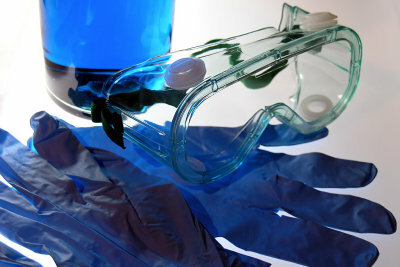Products in the bromination of ethane and explanation of the reaction
The bromination of ethane can produce various products, depending on the concentration and energy input. But no matter which product is created, the reaction process always remains the same.

Bromination of ethane
- The bromination of ethane occurs through radical substitution.
- When exposed to UV radiation, bromine is split homolytically, so that two neutral radicals are formed. This creates two atomic bromine radicals from one bromine molecule. The chemical equation for this split is: Br2 → 2 Br . .
- The bromine radical then combines with a hydrogen atom of the ethane and thus splits it off homolytically from the ethane. So a C is created2H5. and hydrogen bromide as products.
- In the simple bromination of ethane, the C then combines2H5.-Radical with a bromine atom of a bromine molecule, so that bromoethane and a bromine radical are formed. The reaction equation looks like this: C.2H5. + Br2 → C2H5Br + Br . .
- The bromine radical can now bond again with a hydrogen atom of an ethane, so that another ethane radical is formed. So there is a chain reaction.
- The chain reaction can be terminated when two radicals combine with each other. There are three different options for doing this.
- Two bromine radicals combine to form another bromine molecule: 2 Br .→ Br2
- Alternatively, an ethane radical can combine with a bromine radical: C2H5. + Br .→ C2H5Br
- Of course, two ethane radicals can also bond to form butane: 2 C2H5. → C4H10
Ethane, ethene and ethine - the structural formulas simply explained
The chemical substances ethane, ethene and ethyne belong to the groups of alkanes, alkenes ...
Radical substitution products
- By far the most common of the products in the radical substitution of ethane with bromine is of course simple bromoethane.
- Occasionally or increasingly through appropriate test conditions, however, two different hydrogen atoms are also replaced by bromine, so that 1,2-dibromoethane is formed. As the name suggests, each of the two carbon atoms has only one bond to one bromine atom.
- As already described for the termination reactions, however, two ethane radicals can also react with one another, so that butane is also a by-product of the bromination of ethane.
- In the case of very high concentrations of bromine and a correspondingly high energy expenditure, further brominations are also conceivable, so that, for example, 1,1,2-tribromoethane could also be formed.
- Since butane is produced as a by-product, it is also possible that 2-bromobutane is produced occasionally. 1-bromobutane is unlikely because radical formation (due to its stability) takes place on the central carbon atoms.
How helpful do you find this article?
